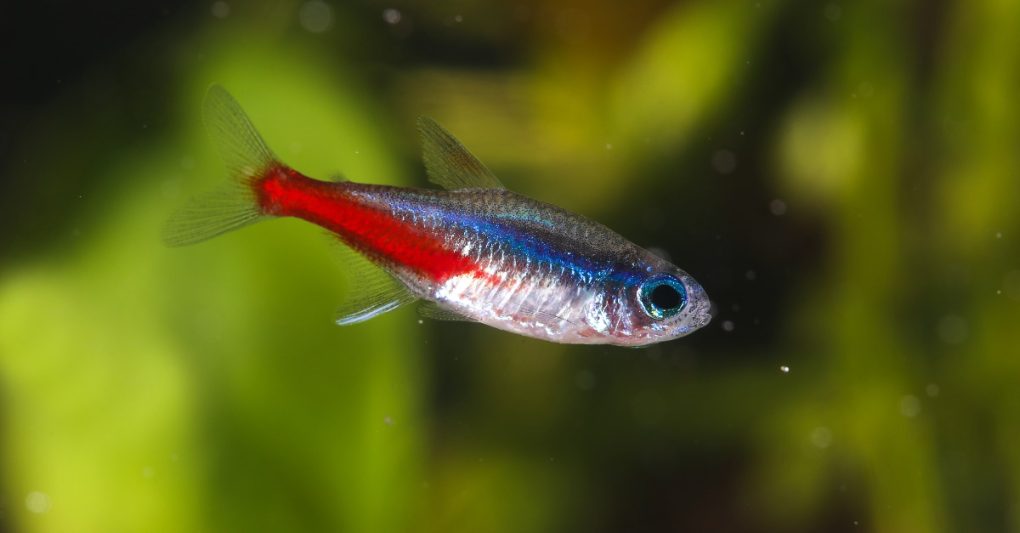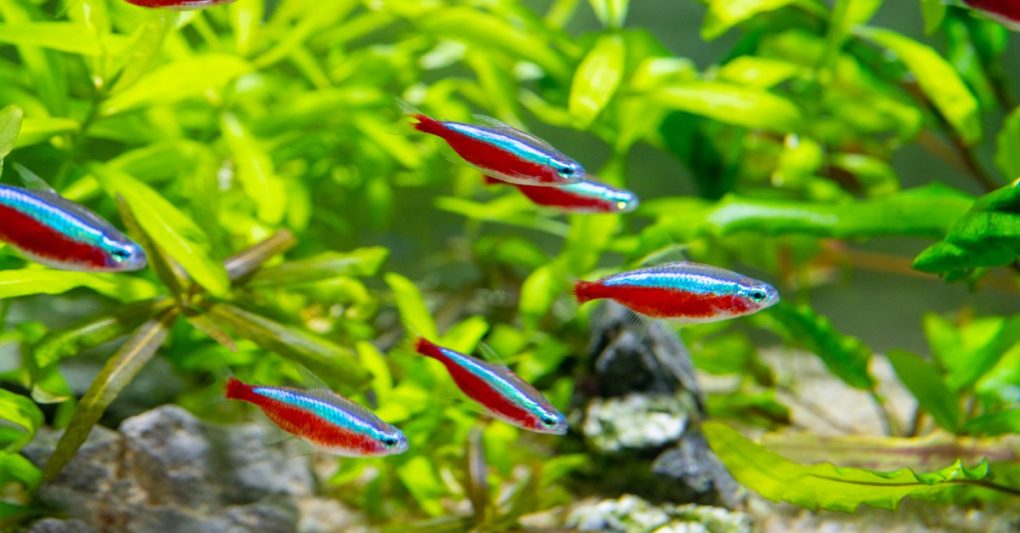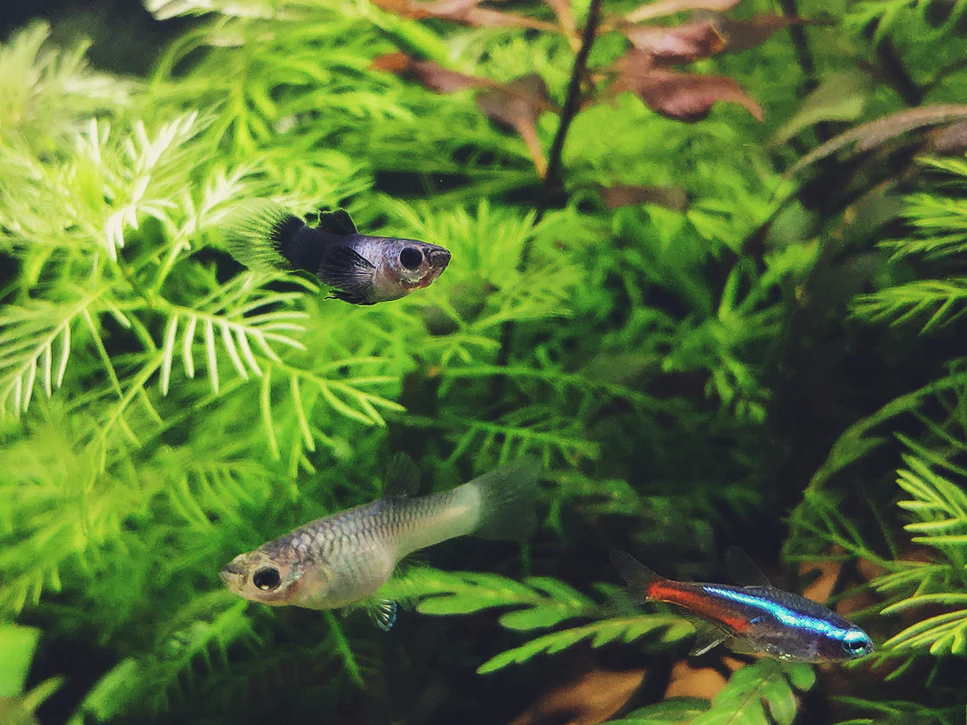Neon Tetra | A to Z Guide – Care, Tank Mates, Size, and Diet

Neon tetras are one of the sought-after fish species in the market today.
In addition to their peaceful and non-aggressive temperament, you’ll love how vibrant and shiny their colors are when they swim altogether.
Further, you’ll find the ultimate guide for keeping healthy and happy neon tetras in your home tank. We’ll also cover other additional guidelines, such as tank size, mates, foods, and breeding process.
Table of Contents
Overview/Origin
Neon tetras (Paracheirodon innesi) are freshwater fish belonging to the Characidae family, native to the streams and rivers of South America and the Amazon river basin. They’re considered small schooling fish (usually have at least 15 members) and are middle-dwellers of the tank.
Moreover, fishkeepers particularly love neon tetras’ sensational coloring. There’s little to worry about territorial issues in the tank since neon tetras are peaceful and non-aggressive fish species.
Neon tetras aren’t fussy about food and diet but are sensitive to water conditions to survive. They’re challenging to produce as they have very particular parameters to induce breeding (we’ll save this for later).
Appearance

Neon tetras display a colorful, vibrant appearance that aquarists find attractive compared to other tetra varieties. There is also a purple tetra which is small, colorful fish that is known for its playful and entertaining behavior. They have tiny and slim body that extends up to 1.5 to 2.5 inches (3.8 to 6.3 cm) in length. Neon tetras have large and broad eyes, which makes up the majority of their head.
Their bodies encompass a bright blue stripe that runs iridescently from their nose to the adipose fin. There’s a stunning, red horizontal stripe that’s running along half its body. Besides, their bellies are colored in neutral white. For this reason, they’re commonly mistaken for Cardinal Tetras.
Further, these characteristics help improve visibility despite the murky and muddy water conditions.
Neon tetra’s sex identification is a little tricky. Yet, one of the ways to identify males from females is by comparing their body size. Male tetras have slimmer bodies, which creates a “straight” blue line. Meanwhile, female tetras are rounder in shape, producing a “curved” blue line.
Behavior and Temperament
Are Neon Tetras aggressive?
Neon tetras are non-aggressive, peaceful fish species. Their pleasant temperament makes them timider, creating less stress and territorial issues in the tank. It’s worth mentioning that they are schooling fish; it’s preferable to have a home tank dedicated to small fishes or many other tetras they can be around.
They typically love to swim in the middle layer of the tank and do well with other fish with the same personality. Because neon tetras are small, it’s best to keep them with fish of a similar size to avoid being eaten by large fish species (such as cichlids).
Further, fishkeepers find neon tetras’ fantastic colors that blend together when they move in groups. This gives aquarists (and you) a nice viewing effect and experience worth your buck and time.
Another interesting fact about neon tetras is that their colors change depending on how happy they are in their tank. As such, you’ll see their colors bloom when they’re chilling or appear faded when they’re stressed.
Lifespan
How long do Neon Tetras live?
Despite neon tetras’ small appearance, they have a really long lifespan. They could live between 5 to 8 years in captivity, considering the correct tank environment, water parameters, and diet.
Common diseases
Neon tetras are vulnerable to certain types of diseases, especially the “neon tetra disease.” Here are conditions you to look after:
- Neon tetra disease. This disease is mainly caused by Pleistophora hyphessobryconis that enters a neon tetra’s body and makes it a host. Once inside, the parasite eats the fish from the inside out. Take note that this is a highly infectious disease, which could spread in your home tank quickly. There’s still no cure for neon tetra disease, but the best way to avoid it is to keep tank water high-quality and clean.
- Fin rot. A stressed environment might actually cause neon tetras to develop fin rot disease. Moreover, overcrowded tanks, too much transfer process, overfeeding, and poor water quality also contributes to rotting fins. Symptoms involved inflamed body, bloody patches, and dead flesh.
- Fungal infections. Another disease to look out for is the ones caused by fungi. The disease is characterized by eye discoloration and white cottony growths on an infected neon tetra’s body. Causes of fungal infections might include substandard water quality, open wounds, and infected food.
- White spot disease (Ich). Any freshwater aquarium fish are susceptible to white spot disease. Ich (or ick) infects neon tetras and develops small blisters and raised lesions on the body or fins. Further, adding salt or changing the water parameters are the most common treatments to cure a neon tetra infected with this disease.
- Bacterial infections. This disease is also referred to as “false neon tetra disease.” It’s characterized by white patches on the mouth, back, and tail regions. Besides, infected neon tetras suffer from cloud eyes and ulcers.
- Protozoan invasion. Neon tetras might suffer from a protozoan invasion, contagious to other fish species in your tank. Symptoms of this disease involve neon tetras having dull colors and abnormal spine curves.
Furthermore, keep your neon tetras healthy by practicing good tank care and treatment. Ensure you maintain the optimal tank conditions and regularly clean the aquarium.
Size
How big do Neon Tetras get?
Neon tetras can grow between 1.5 to 2.5 inches (3.8 to 6.3 cm) in length. Yet, their growth primarily depends on their tank environment and water parameters.
How many Neon Tetras can be kept in a tank?
Keep in mind that neon tetras love to belong in a school of six to ten tetras. To cater to this fish community, consider a 10-gallon tank size for their environment.
As a rule of thumb, consider the tetra’s length when adding them into the tank. Furthermore, add a gallon of water for every one-inch fish’s length you cater to in the tank.

Neon Tetras Care
Tank Size
A suggested ratio of one neon tetra to 1.5 to 2 gallons of water is recommended when keeping a school of this fish species.
To keep a school of neon tetras, the minimum tank size would be about 10 gallons and be in a nano-tank form. The optimal would be a 20-gallon tank size.
Even though they’re small, it’s crucial to provide enough room for the whole crew. This process reduces stress and overcrowding, which are the leading causes of neon tetra diseases.
Tank Setup
Neon tetras are native to South America’s warm rivers, which generally have thick and dense canopies that block the natural sunlight. To replicate neon tetras’ native environment, consider the following elements when setting up their home tank:
- Plant decorations. Knowing neon tetras’ environment boils down to a conclusion: your home tank needs to be heavily planted, giving them a “cover.” They typically hide on plants whenever they feel threatened. Yet, your tank should have enough room for your tetras to swim in.
- Standard sponge filter. In addition to plants, install a small, air-powered sponge filter to give your little tetras a gentle water flow. A standard sponge filter is advisable to keep the tank water clean at all times.
- Lighting. Since neon tetras originated from blackwater environments (and aren’t fans of bright light), considering subdued lighting will do. Neon tetras would be happy to keep their water tank dim. You’ll also be surprised at how shiny their colors get when watching them swim in a school.
- Heater. Remember that neon tetras are more sensitive to changes in water conditions. Therefore, you’ll need a heater to keep the water at a constant temperature.
- Substrates. Since tetras are generally mid-dwellers, substrates would be optional. Nonetheless, make sure to use dark-colored grains to replicate their natural environment even more.
- Driftwoods and dried leaves. Mimic neon tetras’ original environment by putting driftwoods. These elements create a darker and shader environment for them conveniently. Meanwhile, the dried leaves help stain the water, giving the tank an authentic and muddy look.
Water conditions
As mentioned earlier, neon tetras are fussy about water conditions. Since they came from the Amazon river basin, it’s best to replicate their environment as much as possible. Thus, cater to the following water parameters for neon tetras:
- Temperature. Considering the climate of neon tetras’ origin, opt for a temperature between 70° to 81° Fahrenheit (21° to 27.2° Celsius).
- pH range. In terms of pH levels, keep your neon tetras’ tank between 6.0 to 7.0 for consistency.
- Hardness (dH). Finally, keep the water hardness not exceeding 10 dH.
Remember that neon tetras are also discreet about water changes. Further, perform a 25% water change weekly. Anything more than the required percentage could be deadly to your fish species.
Diet and Feeding
What do Neon Tetras eat?
Neon tetras are omnivores, which means they can survive in both plants and meats as their food source. You’ll love the fact that they aren’t picky about foods as well.
In their native environment, neon tetras typically indulge in organic matters found in water. Since they’re in captivity, it’s best to feed them foods that’ll make most of their meals.
Food neon tetras can take as follows:
- Standard flake food
- High-quality pellets
- Frozen foods
- Bloodworms
- Brine shrimp
- Insect larvae
- Algae
- Miniscule invertebrates
- Tubifex
- Daphnia
How often should I feed my Neon Tetras?
Adult neon tetras can be fed once a day with healthy meals. On the one hand, young tetras need to eat meals between two to three times a day. Make sure to induce foods that are consumable in three minutes to avoid water pollution from leftovers.
How long can Neon Tetras go without food?
Neon tetras are small fish species. Thus, they couldn’t make it long enough to survive without food for more than a week.
Tank Mates
As stated, neon tetras are non-aggressive, peaceful fish species (but aren’t when mating season begins). In fact, they make perfect tank mates with pleasant bottom-dwellers, which reduces the chances of overcrowding and territorial issues.
When keeping other fish species, keep in mind not to incorporate larger fishes; neon tetras would only get eaten or threatened.

Furthermore, here are the fish species that get along with neon tetras:
- Barbs
- Rasboras
- Dwarf gouramis
- Other tetras species: black skirt tetras, black neons, and cardinal tetras
- Corydoras catfish
- Dwarf cichlids
- Snails
- Clownfish
- Livebearers
- Guppies
- Ghost shrimp
- Glofish
Subsequently, avoid having these fish species with neon tetras in the same tank:
- Angelfish
- African Cichlids
- Bettas
- Jack Dempsey
Breeding
You can breed neon tetras in their home tank by triggering the “mating season.” However, it’s not as easy as it can be. Feeding them with protein-rich food for two weeks can help.
Note: Tetras are very picky with the right tank and water conditions—a slight change might trigger a negative effect.
To start the process, you’ll need to identify their sexes. Tetras are “egg scatterers,” meaning female tetras lay eggs, and males fertilize them. Moreover, parents don’t care for their fry and have been known to eat the eggs.
To avoid this from happening, setting up the spawning or breeding tank would be ideal. After spawning eggs, keep the parents for about five days in the tank. Remove them after seeing a 50% water change.
If you want to observe the eggs, use a dim flashlight. Any strong source of light might kill the eggs and fry.
Once hatched, the fry feeds on their egg sacks for a couple of days. After that, provide them with small quantities of meals or liquid fry food. You can feed them with baby brine shrimp once they grow large enough.
Summary
Overall, aquarists find neon tetras a great addition to a colorful home tank, thanks to their vibrant and shiny colors.
Furthermore, there’s a reason why fishkeepers find neon tetras a popular one in the aquarium.
Their pleasant behaviors and non-aggressive attributes let them go along well with other peaceful species. Nevertheless, make sure to keep them in a happy and bigger community.
Finally, they’re very selective about water conditions, which many find a challenge when breeding neons.